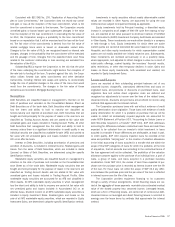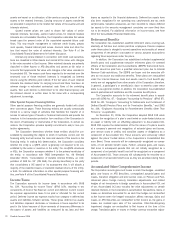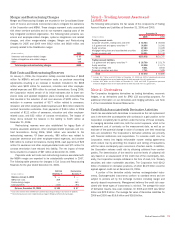Bank of America 2006 Annual Report Download - page 107
Download and view the complete annual report
Please find page 107 of the 2006 Bank of America annual report below. You can navigate through the pages in the report by either clicking on the pages listed below, or by using the keyword search tool below to find specific information within the annual report.change in the estimated timing of the cash flows relating to income taxes
generated by such leveraged lease. FSP 13-2 is effective as of January 1,
2007 and requires that the cumulative effect of adoption be reflected as
an adjustment to the beginning balance of Retained Earnings with a corre-
sponding offset decreasing the net investment in leveraged leases. The
adoption of FSP 13-2 is expected to reduce Retained Earnings by approx-
imately $1.4 billion after-tax in the first quarter of 2007. This estimate
reflects new information that changed management’s previously disclosed
assumption of the projected timing and classification of future income tax
cash flows related to certain leveraged leases.
On July 13, 2006, the FASB released FASB Interpretation No. 48,
“Accounting for Uncertainty in Income Taxes, an interpretation of FASB
Statement No. 109” (FIN 48). FIN 48 clarifies the accounting and reporting
for income taxes where interpretation of the tax law may be uncertain. FIN
48 prescribes a comprehensive model for the financial statement recog-
nition, measurement, presentation and disclosure of income tax
uncertainties with respect to positions taken or expected to be taken in
income tax returns. The Corporation will adopt FIN 48 in the first quarter of
2007. The adoption of FIN 48 is not expected to have a material impact
on the Corporation’s financial condition and results of operations.
On March 17, 2006, the FASB issued SFAS No. 156, “Accounting for
Servicing of Financial Assets, an amendment of FASB Statement No. 140”
(SFAS 156), which permits, but does not require, an entity to account for
one or more classes of servicing rights (i.e., mortgage servicing rights, or
MSRs) at fair value, with the changes in fair value recorded in the Con-
solidated Statement of Income. The Corporation elected to early adopt the
standard and to account for consumer-related MSRs using the fair value
measurement method on January 1, 2006. Commercial-related MSRs
continue to be accounted for using the amortization method (i.e., lower of
cost or market). The adoption of this standard did not have a material
impact on the Corporation’s financial condition and results of operations.
For additional information on MSRs, see Note 8 of the Consolidated Finan-
cial Statements.
On February 16, 2006, the FASB issued SFAS No. 155, “Accounting
for Certain Hybrid Instruments, an amendment of FASB Statements
No. 133 and 140” (SFAS 155), which permits, but does not require, fair
value accounting for any hybrid financial instrument that contains an
embedded derivative that would otherwise require bifurcation in accord-
ance with SFAS No. 133 “Accounting for Derivative Instruments and Hedg-
ing Activities, as amended” (SFAS 133). The statement also subjects
beneficial interests issued by securitization vehicles to the requirements
of SFAS 133. The Corporation will adopt SFAS 155 in the first quarter of
2007. The adoption of SFAS 155 is not expected to have a material
impact on the Corporation’s financial condition and results of operations.
On January 1, 2006, the Corporation adopted SFAS No. 123 (revised
2004), “Share-based Payment” (SFAS 123R). Prior to January 1, 2006,
the Corporation accounted for its stock-based compensation plans under a
fair value-based method of accounting. The adoption of SFAS 123R
impacted the recognition of stock compensation for any awards granted to
retirement-eligible employees and the presentation of cash flows resulting
from the tax benefits due to tax deductions in excess of the compensation
cost recognized for those options (excess tax benefits) in the Consolidated
Statement of Cash Flows. For additional information, see Note 17 of the
Consolidated Financial Statements.
Cash and Cash Equivalents
Cash on hand, cash items in the process of collection, and amounts due
from correspondent banks and the Federal Reserve Bank are included in
Cash and Cash Equivalents.
Securities Purchased under Agreements to Resell
and Securities Sold under Agreements to Repurchase
Securities Purchased under Agreements to Resell and Securities Sold
under Agreements to Repurchase are treated as collateralized financing
transactions and are recorded at the amounts at which the securities were
acquired or sold plus accrued interest. The Corporation’s policy is to
obtain the use of Securities Purchased under Agreements to Resell. The
market value of the underlying securities, which collateralize the related
receivable on agreements to resell, is monitored, including accrued inter-
est. The Corporation may require counterparties to deposit additional col-
lateral or return collateral pledged, when appropriate.
Collateral
The Corporation has accepted collateral that it is permitted by contract or
custom to sell or repledge. At December 31, 2006, the fair value of this
collateral was approximately $186.6 billion of which $113.0 billion was
sold or repledged. At December 31, 2005, the fair value of this collateral
was approximately $179.1 billion of which $112.5 billion was sold or
repledged. The primary source of this collateral is reverse repurchase
agreements. The Corporation also pledges securities as collateral in
transactions that consist of repurchase agreements, public and trust
deposits, Treasury tax and loan notes, and other short-term borrowings.
This collateral can be sold or repledged by the counterparties to the trans-
actions.
In addition, the Corporation obtains collateral in connection with its
derivative activities. Required collateral levels vary depending on the credit
risk rating and the type of counterparty. Generally, the Corporation accepts
collateral in the form of cash, U.S. Treasury securities and other market-
able securities. Based on provisions contained in legal netting agree-
ments, the Corporation has netted cash collateral against the applicable
derivative mark-to-market exposures. Accordingly, the Corporation offsets
its obligation to return or its right to reclaim cash collateral against the fair
value of the derivatives being collateralized. The Corporation also pledges
collateral on its own derivative positions which can be applied against
Derivative Liabilities.
Trading Instruments
Financial instruments utilized in trading activities are stated at fair value.
Fair value is generally based on quoted market prices. If quoted market
prices are not available, fair values are estimated based on dealer quotes,
pricing models or quoted prices for instruments with similar character-
istics. Realized and unrealized gains and losses are recognized in Trading
Account Profits.
Derivatives and Hedging Activities
The Corporation designates a derivative as held for trading, an economic
hedge not designated as a SFAS 133 hedge, or a qualifying SFAS 133
hedge when it enters into the derivative contract. The designation may
change based upon management’s reassessment or changing circum-
stances. Derivatives utilized by the Corporation include swaps, financial
futures and forward settlement contracts, and option contracts. A swap
agreement is a contract between two parties to exchange cash flows
based on specified underlying notional amounts, assets and/or indices.
Financial futures and forward settlement contracts are agreements to buy
or sell a quantity of a financial instrument, index, currency or commodity at
a predetermined future date, and rate or price. An option contract is an
agreement that conveys to the purchaser the right, but not the obligation,
to buy or sell a quantity of a financial instrument (including another
derivative financial instrument), index, currency or commodity at a pre-
Bank of America 2006
105
























